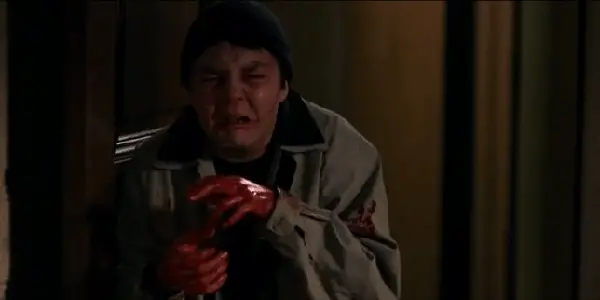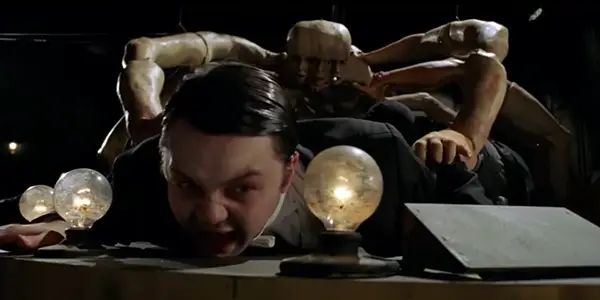THE EVIL WITHIN: Andrew Getty’s Bizarrely Original Passion Project Is A Sight to Behold

David is a film aficionado from Colchester, Connecticut. He enjoys…
The Evil Within is a film that doesn’t initially seem to stand out; having been sent straight to Amazon Video, one’s first thought would be that it was nothing better than the plethora of unremarkable horror films that often flood VOD platforms. But after gazing deeper behind the production, as I did after first hearing of the film’s existence, your interest might be piqued.
Directed by Andrew Getty, grandson of J. Paul Getty, the founder of Getty Oil Company, it was filmed and finalized over a total of 15 years, and largely through Andrew Getty‘s own fortune. It became a work of obsession for him, and even after filming was complete he spent years on post-production, turning one full room of his mansion into a production suite and utilizing unique special effects in his hopes of perfecting the film frame by frame.
In 2015, though, Getty unfortunately died before he could finish the film, due to heart complications related to methamphetamine use. Over the next two years, a producer of the film, Michael Luceri, made it his mission to finish the remainder, coloring and editing the film as Getty would have desired. The result is The Evil Within; an eccentric, uneven, unbelievably campy film that, though clearly the work of an amateur director, has an inescapably alluring quality to it as well. Anyone who feels even the slightest bit intrigued, especially those that are fans of the macabre, should instantly climb on board.
David Lynch Meets Tim Burton
The Evil Within was birthed out of Getty‘s own dreams as a kid, which he often described as nightmarishly real. The film asks the question: what if those nightmares, instead of being your mind’s own creations, were actually the result of some other entity feeding those visions to you?
The story is about a boy named Dennis Peterson (Frederick Koehler), a special-needs kid who lives with his older brother John (Sean Patrick Flannery). Haunted by his frightening dreams, Dennis one day finds that the specter he often sees in those dreams (played by the always wonderful Michael Berryman from the original The Hills Have Eyes), has now started to appear in his waking life as well. In a series of back-and-forth conversations in a mirror, he communicates with this monster, who convinces him to start committing ghastly tasks in exchange for his release from the dreams.

With inklings of demonic possession and its eventual tread into slasher territory, it seemingly has all the makings of a silly B-horror film, and in a way, The Evil Within really does belong in that category. The story itself, for example, is riddled with strange and unfocused plot-lines. The main plot consists of Dennis, who lives with his brother John due to being of special needs, and his presence appears to be interfering with his brother’s social life, especially when it comes to John’s longtime girlfriend Lydia (Dina Meyer). Such a conflict creates a rift within the household, but what results from this is seemingly unrelated to the eventual horror that occurs, and even within the context of a B-horror film, it makes little sense. It’s as if, in an effort to make The Evil Within have some sort of basis behind its story, Getty half-cooked up this bare-threads plot.
Much of the film is also filled with cringeworthy character acting. Though one can’t entirely blame Frederick Koehler for his interpretation of a special needs kid which is just shy of offensive, it is his incessantly repetitive back and forth conversations with his “other self” that start to wear out their welcome. Character interactions outside of Dennis’ are similarly hokey, such as nearly every conversation between Sean Patrick Flanery‘s John and Dina Meyer‘s Lydia, which circle around to clichéd and overblown topics of marriage and having a future together.
One shouldn’t really care about story, though, because we didn’t come here for anything particularly deep or meaningful. Instead, we came here for some weird shit. And, on that ground, The Evil Within delivers. The film begins in a surreal dream similar to what you would see in a David Lynch film, combined with the stop-motion effects more often used by Tim Burton‘s early work. The animatronic special effects and other otherworldly creations are particularly impressive throughout, such as in one scene where Dennis is watching a science show about how spiders are renowned cannibals, and then witnesses a gargantuan tarantula creeping up next to him in bed. At other points, he witnesses a woman with mouths for eyes, and in the film’s final sequence, just about the strangest puppet show you’ve ever seen.

It is these nuanced details that help to raise The Evil Within above its flaws, shedding light on the sheer passion and strength of will that was undertook in its production. Take the mirror scenes, as another example. At one point, by request of the monster, Dennis points two mirrors at each other and stares at his never-ending reflection in each. Upon closer examination, however, the reflection is not just of him, because about 6 frames in you can see the monster, far away yet also perched next to him, eerily gazing at and grasping onto the boy, who can only see him through the mirror. Later on, the camera takes off and travels through this self-created mirror world, much like a spaceship through a wormhole. To see and witness scenes like this, and to recognize that much of these effects are hand-created, makes The Evil Within an all the more admirable creation.
Passion Meets Madness in The Evil Within
It is often said that there is a very fine line between genius and insanity. The Evil Within is living proof of this. Addicted to methamphetamines for much of its production, Getty slaved for years over the production of the film, throwing much of his own fortune into it, with the hope that it would spark an eventual career in the movie industry. It’s hard to know, though, just what exactly was going through his mind for all this time. Certain embellishments in the film, such as an animatronic octopus that plays the drums, appear for seconds at the most, and yet they must have taken months to design.
Other sequences, such as one involving a girl that works at an ice cream store, don’t really work themselves into the larger plot. Eventually, much like the nightmares themselves, The Evil Within becomes so wrapped up in its own eccentricities that it is all but impossible to follow coherently.
Yet, you can’t quite put a limit on passion. Since we will never know if Andrew Getty would have had an eventual career in the industry after his 15-year production, we’ll just have to settle with The Evil Within. It’s far from flawless, but it’s hard to argue with that much devotion to this singularly distinguished work of art.
What did you think of The Evil Within? Is it worth the 15 years that it took to create? Tell us your thoughts in the comments below!
The Evil Within is available on Amazon Prime and on VOD platforms.
https://youtu.be/k2Ii4AaiBKIDoes content like this matter to you?
Become a Member and support film journalism. Unlock access to all of Film Inquiry`s great articles. Join a community of like-minded readers who are passionate about cinema - get access to our private members Network, give back to independent filmmakers, and more.
David is a film aficionado from Colchester, Connecticut. He enjoys writing, reading, analyzing, and of course, watching movies. His favorite genres are westerns, crime dramas, horror, and sci-fis. He also enjoys binge-watching TV shows on Netflix.













